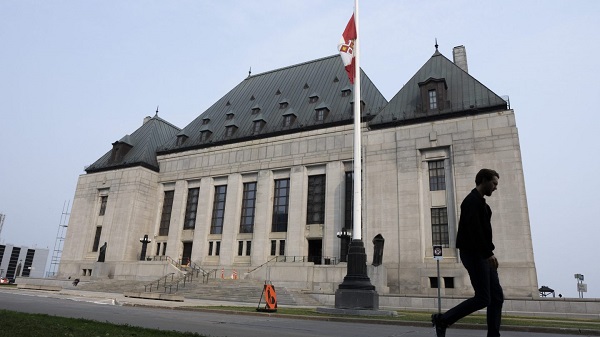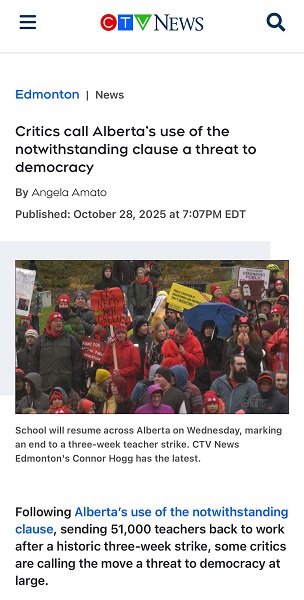Alberta
‘Canada should be bold and more intentional…and respond to a world thirsty for more Canadian-made energy, food and critical minerals’

From the Canadian Energy Centre
Bare minimum amendments to Impact Assessment Act ‘do little’ to address Supreme Court’s concerns
One year ago, the Supreme Court of Canada found the federal government’s law to assess major projects like pipelines and highways breaks the rules of the Canadian constitution.
There’s a good chance it still does, despite amendments enacted this spring.
Lawyers with firms including Osler, Hoskin & Harcourt, Bennett Jones and Fasken have warned that Ottawa’s changes to the Impact Assessment Act (IAA) leave it open to further constitutional challenges.
One could come from Alberta as soon as November 1, following a four-week deadline set by Premier Danielle Smith for the federal government to address the province’s concerns.
“I don’t think that the amendments have responded adequately to the Supreme Court of Canada’s decision,” says Brad Gilmour, a partner at Osler, Hoskin & Harcourt who co-argued Alberta’s successful 2023 reference case to the Supreme Court.
The governments of Ontario, British Columbia, Saskatchewan, Quebec, Newfoundland and Labrador, New Brunswick and Manitoba supported Alberta’s case, arguing that the IAA had exceeded federal jurisdiction.
The Supreme Court largely agreed, while allowing that there is a place for federal assessment of major projects.
“The court had some significant concerns about federal overreach into areas of provincial jurisdiction, and I think that the amendments have done really little to address that broad concern,” Gilmour says.
“They’ve made very minor changes to the sections that the courts found to be unconstitutional, and the wording they use lacks clarity and lacks certainty.”
Components of the IAA that the Supreme Court found unconstitutional include the decision that starts the process – whether a project requires a federal impact assessment and the decision at its conclusion – whether or not a project should receive final approval to proceed.
“It appears the government has done the minimum possible to address the Supreme Court’s concerns, adding qualifiers to its areas of authority, but failing to correct the legislation’s negative impacts on the pace, cost and efficiency of project approvals,” wrote the Business Council of Canada’s Michael Gullo and Heather Exner-Pirot.
“Canada can’t wait and should be bold and more intentional in its effort to grow market share and respond to a world thirsty for more Canadian-made energy, food and critical minerals.”
According to Gullo and Exner-Pirot, the negative impact of the IAA legislation, which came into effect in 2019, can be seen in Canada’s national inventory of major resource projects.
In 2015, there were 88 energy projects completed with a value of $53 billion. In 2023, that figure halved to 56 completed projects with a value of $26 billion.
Alberta’s government says it has “made repeated requests” for the federal government to consult with the province on the amendments, to no effect.
“Alberta is not taking their foot off the pedal in pushing back,” Exner-Pirot told CEC.
“Our country’s energy and natural resources cannot be developed in a timely and economic manner under the current federal regulatory regime. This is affecting not only the economy, but also our security and our efforts to move to lower emitting energy sources.”
Alberta
Province orders School Boards to gather data on class sizes and complexity by Nov 24

Better data, better outcomes for Alberta students |
To help schools address classroom complexity, Alberta’s government will begin collecting annual data on class size and composition.
Over the past three years, Alberta has welcomed more than 80,000 new students. With this unprecedented growth, classroom complexity and class sizes are among the biggest issues facing schools and teachers across the province.
To meet this challenge head on, Alberta’s government will work with school boards to gather yearly data on class sizes and composition. This information will be used to better understand staffing, student needs and classroom complexity. School boards will be required to submit data on Alberta classrooms by Nov. 24, and by January, this data will be made publicly available and will then be released annually.
Data collected on classroom complexity will help the province understand and address issues in schools, including class sizes, and support strategic investments in classrooms. Over the next three years, school boards will be provided with funding to hire 3,000 teachers and 1,500 new education assistants to support students with complex needs.
“We are ready to work with school boards and teachers to address classroom complexity and class sizes. We have heard them loud and clear and we are taking bold action to address these issues.”
Alberta’s government is establishing a Class Size and Complexity Task Force to begin work immediately on identifying solutions to the challenges facing Alberta classrooms. Alongside new annual data collection, the task force will ensure every student gets the attention and support they need to succeed. Details about the task force will be shared in the coming weeks.
“This data will provide essential insight into classroom realities, guiding evidence-based decisions and advocating for sustainable funding to address complexity, ensuring every student and educator in Alberta has the support to thrive.”
Quick facts
To inform decisions on addressing classroom complexity, data will be collected on total numbers of:
- all staff, per school, including roles
- substitute teachers
- district staff, listed by job title
- students, per classroom, per school
- severe, mild/moderate, and gifted/talented students, per classroom, per school
- English as an additional language (EAL) students, per classroom, per school
- refugee students, per classroom, per school
- First Nations, Métis and Inuit students, per classroom, per school
- Individualized Program Plans, per classroom, per school
- students waitlisted for assessment, per classroom, per school
- incidents of aggression and violence
- $55 million was provided in Budget 2025 to address classroom complexity.
- 8.6 billion is being invested to build and renovate more than 130 schools across the province.
- Budget 2025 is investing $1.6 billion in learning support funding to help meet students’ specialized learning needs.
- Budget 2025 is investing $1.1 billion to hire more than 4,000 teachers and educational staff.
Alberta
How one major media torqued its coverage – in the take no prisoners words of a former Alberta premier

(Editor’s note: I was going to write on the media’s handling of the Alberta government’s decision to order striking teachers back to work and invoke Section 33 of the Charter in doing so. But former Alberta premier Jason Kenney provided such a fulsome dissection of an absence of balance and its consequences in terms of public trust on X that I asked him if The Rewrite could publish it. He said yes and here it is – Peter Menzies.)
By Jason Kenney
This ”story” is an object lesson for why trust in legacy media has plummeted, and alt right media audiences have grown.
”story” is an object lesson for why trust in legacy media has plummeted, and alt right media audiences have grown.
Here CTV “digital news producer” @AngeMAmato (she/her) writes a story about “experts” calling the use of Sec. 33 “a threat to democracy.”
Who are the experts?
A left wing academic, and a left wing activist. The latter, Howard Sapers, is a former Liberal MLA (which the article does not mention) for a party that is so marginal, it has not elected an MLA in over a decade.
For good measure CTV goes on to quote two left wing union bosses, who of course are predictably outraged.
A more accurate headline would be “Four people on the left angry about use of Notwithstanding Clause.” Which is the opposite of news. It’s the ultimate “Dog Bites Man” non-story.
Did the CTV producer make any effort to post a balanced story by asking for comment from academics / lawyers / think tanks who support use of Sec. 33? Did she call the @CDNConstFound or the @MLInstitute’s Judicial Power Project? Did she attempt to reach any of these four scholars, who just published their views in a @nationalpost op-ed last week?
Did she have an editor who asked why her story lacked any attempt at balance?
And did anyone at CTV pause for a moment to ponder how tendentious it is to accuse a democratically elected legislature of acting “undemocratically” by invoking a power whose entire purpose is to ensure democratic accountability?
She provides some historical context about prior use of Sec. 33. Why does that context not include the fact that most democratically elected provincial governments (including Alberta under Premier Lougheed, and Saskatchewan under NDP Premier Blakeney) agreed to adopt the Charter *only if* it included the Notwithstanding Clause to allow democratically elected Legislatures to ensure a democratic check and balance against the abuse of undemocratic, unaccountable judicial power?
Why does she not mention that for the first 33 years of the Charter era, the Canadian Courts ruled that there was no constitutionally protected right to strike?
Why doesn’t she quote an expert pointing out that Allan Blakeney defended the Saskatchewan Legislature’s 1986 use of Sec. 33 to end a strike as “a legitimate use of the Clause?” Or refer to Peter Lougheed’s 1987 commitment to use Sec. 33 if the courts invented a right to strike?
Many thoughtful criticisms can be levelled against Section 33. Being undemocratic is not one of them.
So why do we see so much agitprop like this masquerading as news from so many legacy media outlets?
IMO, there are two possible answers:
1) They are blind to their own biases; and / or
2) People like @AngeMAmato believe that they have a moral imperative to be “progressive journalists” which trumps the boringly old fashioned professional imperative to be objective and balanced.
Whatever the reason, “journalists” like this have no one to blame but themselves for growing distrust of legacy media, and the consequent emergence of non traditional media platforms.
 |
|
Invite your friends and earn rewards
-

 Business1 day ago
Business1 day agoCanada heading into economic turbulence: The USMCA is finished and Canadian elbows may have started the real fight
-

 Internet2 days ago
Internet2 days agoMusk launches Grokipedia to break Wikipedia’s information monopoly
-

 Business2 days ago
Business2 days agoBill Gates walks away from the climate cult
-

 National1 day ago
National1 day agoCanadian MPs order ethics investigation into Mark Carney’s corporate interests
-

 National1 day ago
National1 day agoCanada’s NDP is now calling women ‘non-males’
-

 Business1 day ago
Business1 day agoFord’s Liquor War Trades Economic Freedom For Political Theatre
-

 Banks1 day ago
Banks1 day agoBank of Canada Cuts Rates to 2.25%, Warns of Structural Economic Damage
-

 Health1 day ago
Health1 day agoLeslyn Lewis urges Canadians to fight WHO pandemic treaty before it’s legally binding







